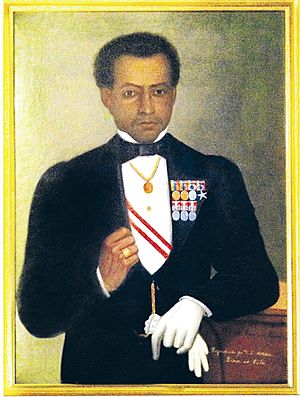Chuquisaca Revolution facts for kids
The Chuquisaca Revolution was an important event that happened on May 25, 1809. People in Chuquisaca (which is now called Sucre in Bolivia) rose up against their leader, Ramón García León de Pizarro. A group called the Real Audiencia of Charcas, along with teachers from the University of Saint Francis Xavier, removed the governor and created a new governing group called a junta. In Bolivia, this revolution is often called the "First cry of freedom." This means it was seen as the very first step towards independence from Spain in Latin America.
Contents
Why the Revolution Started
People in Chuquisaca had several reasons to be unhappy.
Memories of Past Rebellions
Even though almost 30 years had passed, people still remembered the big native uprisings. These were led by Túpac Amarú II and Tomás Katari. These rebellions happened across a huge area, from modern Colombia to Argentina and Chile. They were put down very harshly, and people remembered this.
Trouble in Spain
There was also big news from Spain. French armies, led by Napoleon, had taken over many parts of the country. They even captured the Spanish king, Ferdinand VII. Napoleon put his own brother, Joseph Bonaparte, on the Spanish throne. With no king to lead them, the Spanish people who resisted Napoleon formed their own governing groups called juntas.
How the Revolution Unfolded
The news about King Ferdinand VII being captured worried people in Chuquisaca.
University Debates
At the University of Chuquisaca, there were many important discussions. People debated who should rightfully govern them now. Bernardo de Monteagudo, a student, shared an idea about people governing themselves. This idea became known as the "Syllogism of Chuquisaca."
The Syllogism of Chuquisaca
The "Syllogism of Chuquisaca" was a powerful argument. It basically said:
Shall we follow the fate of Spain or resist in the Americas? The Indies are a personal domain of the King of Spain. The King is impeded to reign. Therefore, the Indies shall govern themselves.
This meant that if the king couldn't rule, then the lands in the Americas (the "Indies") should rule themselves.
The Junta's Actions
The new governing group, the junta, at first said they were still loyal to King Ferdinand VII. They said they suspected the governor, Ramón García León de Pizarro, planned to give the country to Princess Carlota Joaquina. She was the wife of the Portuguese prince, John.
However, from the very beginning, this revolution helped those who wanted full independence. The rebellion spread to La Paz. There, another group called the Junta Tuitiva was formed on July 16. This group clearly wanted to break away from Spain.
End of the Revolution
The uprising in La Paz was more radical. It was violently stopped by an army sent by Viceroy Baltasar Hidalgo de Cisneros. After this, the movement in Chuquisaca lost its support from outside. Finally, forces sent from Lima by Viceroy José Fernando de Abascal ended the Chuquisaca revolution in October.
What Historians Say
Historians still debate what the Chuquisaca Revolution really meant.
Independence or Loyalty?
Some historians believe the Chuquisaca revolution did not intend to become fully independent from the king. They think it was more about disagreements between groups who supported King Ferdinand VII and those who supported Princess Carlota.
Others, like Charles Arnade and Felipe Pigna, argue that the Chuquisaca revolution did support independence. They point to the "Syllogism of Chuquisaca" as proof. This idea clearly suggested that the Americas should govern themselves.
First Cry for Freedom?
Because of this debate, historians also disagree on which revolution was the first to truly declare independence in Spanish America. Was it Chuquisaca or La Paz? Some researchers, like Juan Reyes, say La Paz was first because Chuquisaca kept the Spanish system and didn't fully support La Paz.
Other historians even suggest that the first "libertarian scream" happened in Ecuador. This was because of a revolt in Quito in August 1809.
Chuquisaca's Location
Upper Peru
The area known as Upper Peru is mostly what we call Bolivia today. It was made up of four provinces and two military governments. One of these provinces was Chuquisaca. Its capital city was also called Chuquisaca (or La Plata or Charcas). Today, this city is known as Sucre. It was the main headquarters for the Royal Court of Charcas.
See also
 In Spanish: Revolución de Chuquisaca para niños
In Spanish: Revolución de Chuquisaca para niños


